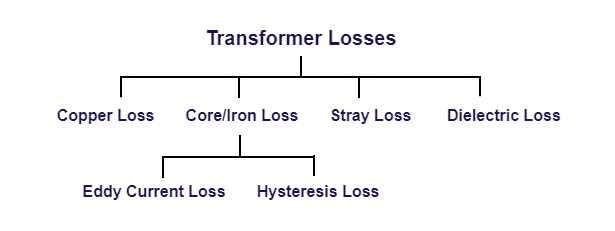
The electrical machine consists of multiple devices like an electrical transformer, electric motor (AC/DC), generator, alternator and so on…
In an earlier article, I have explained the different parts of the transformer. Here, we are studying types of losses in transformer.
I will also explain the different types of losses occurs in different parts of the transformer.
Even though we are talking about the transformer losses, let me tell you that the transformer is more power-efficient and has very low losses.
Why is transformer energy efficient?
Usually, the electrical machine has more losses as there are multiple moving parts like rotor.
The transformer is one of the static device in electrical machine.
Due to the static device (not having any moving parts), mechanical loss (friction loss, bearing loss) does not occur. Only winding or core loss occurs in the transformer.
Due to this, very small losses occur in transformer as compare to the other devices in the electrical machine.
This is also one of the reasons that the transformer is more power-efficient.
Let’s study, what are the types of losses in transformer?
4 Types of Losses in Transformer
Describing each of them in detail.
How can we calculate the losses in transformer?
Generally, power losses of the transformer determine by the Open-circuit test and Closed-circuit test.
These tests help to determine the voltage regulation, circuit constant, and efficiency of the transformer.
Under the construction and working, transformer power losses are divided into two forms.
- Variable loss
- Constant loss
Transformer losses can also be classified into four different categories.
- Copper Loss
- Core Loss
- Stray Loss
- Dielectric Loss
I will explain each of the types of losses in detail.
The core loss is classified into two subtypes. Such as,
- Hysteresis Loss
- Eddy Current Loss
Here is category diagram for transformer losses to understand it easily.

These losses appear in the form of heat. Due to the heat, temperature increases, and power efficiency decreases.
A simple representation of power losses:

Out of this classification, copper and core loss are major losses over other (stray or dielectric) losses.
The stray and dielectric losses have rarely occurred in transformer body parts like a transformer tank, conservator oil tank, breather, winding, etc.
Let’s study each explanation one by one,
1. Copper Loss
Copper loss is called as ‘Ohmic Loss’ or ‘Variable Loss’ or ‘Resistive Loss’.
It occurs in the transformer’s winding (primary winding and secondary winding) which consists of copper (Cu) conductor. So, sometimes core loss is also known as ‘Winding Loss’.
How to reduce copper losses in a transformer?
Copper loss is caused by the ohmic resistance (R) of the transformer winding and electric current (I).

There are two ways we can reduce the core copper losses in the transformer.
- by making winding of the transformer thick so that resistance will get minimized
- by imposing Vacuum Pressure Impregnation (VPI)
How to find the copper loss in transfromer?
It is determined by the Closed-circuit test.
Calculation of Copper Loss:
Copper losses (Pc) is calculated by the given formula,
Copper Loss,(Pc)= (Primary winding Cu loss + Secondary winding Cu loss)= [(I²1*R1)+(I²2*R2)]
Why copper loss is variable loss?
This equation concludes that copper losses vary with the square of load current. Thus, it is called as Variable losses.
Here is the simple calculator to find the value of copper loss if resistance and electrical current are given.
[CP_CALCULATED_FIELDS id=”46″]
2. Core Loss or Iron loss
Sometimes, core loss is known as ‘Magnetizing current Loss’ or Constant Loss‘.
It is caused by the generated alternating flux in the transformer core.
It depends on the core construction and magnetic properties of the core materials like lamination, winding thickness, lamination resistance, component density.
How core loss is determined in transformer?
These losses are determined by the Open circuit test or No-load test.
Core loss consists of two types of losses.
- Eddy Current Loss (Pe)
- Hysteresis Loss (Ph)
Both eddy current loss and hysteresis loss depends on maximum flux density (Bmax) of magnetic field and frequency (f).
I. Eddy Current Loss
Eddy current cause by the changing magnetic field in the transformer core.
It can be reduced by using core thin lamination.
How do you calculate eddy current loss?
Calculation of Core Loss or Iron Loss:
Here is the formula for calculating the value of eddy current loss.
Eddy Current loss, (Pe)= [(ηe)*(B²max)*(F)²*(t)²] (Unit- Watt)
Where, (ηe)- Constant of eddy current loss
Online tool tool calculate the value of eddy loss is given below.
[CP_CALCULATED_FIELDS id=”48″]
II. Hysteresis Loss
Hysteresis loss is caused by the motion of the magnetic field. This loss occurs due to the reversal of magnetism.
It can be reduced by using silicon materials.
Calculation of Hysteresis loss:
According to Steinmetz’s formula, hysteresis loss is calculated by,
Hysteresis loss, (Ph)= [(ηh)*(Bmax1.6)*(F)*(V)] (Unit- Watt)
Where, (ηh)- Constant of hysteresis loss.
Online tool tool calculate the value of Hysteresis loss is given below.
[CP_CALCULATED_FIELDS id=”50″]
The total core losses are determined by the combination of eddy current loss and the hysteresis loss.
Total Core Loss, (Pi)= (Eddy Current loss + Hysteresis loss)= [(Ph)+(Pe)] (Unit- Watt)
You can calculate the value of core losses by using an online calculator.
[CP_CALCULATED_FIELDS id=”47″]
These core losses are reduced by using the silicon content for the core and very thin lamination. Hence, it provides a low reluctance path and high permeability for the flux in the magnetic circuit.
Under the construction of lamination, more power losses occur in core type transformer over shell type transformer.
3. Stray Loss
It is caused by the magnetic leakage flux which produces in the metallic part of the transformer such as a transformer tank, winding, etc.
How to minimize the Stray loss in transformer?
When there is a less leakage current in the transformer, the stray loss gets in the negligible form.
So if we try to minimize the leakage current, stray loss reduces.
4. Dielectric Loss
Dielectric losses are caused by the insulating material and insulation such as transformer oil. It rarely occurs as compared to the core and copper losses.
If the transformer oil or insulation capacity gets deteriorated, the dielectric loss increases.
How to minimize Dielectric loss in transformer?
It can be reduced by two ways.
- by using oil testing
- by maintaining insulation capacity and quality
How to calculate total transformer loss?
Out of all four transformer losses, core losses and copper losses are obtained in the transformer in more quantity. So while calculating, we can neglect stray loss and dielectric loss.
The total calculation of the transformer loss is given by
Total transformer loss, (P)= [Copper loss (Pc)+ Core loss (Pi)] (Unit- Watt)
In this tutorial, I have covered different types of losses in transformer and their formulas with an explanation.
Related read the following Articles:
- Core Transformer vs Shell Transformer
- Classification of the transformer
- Alternating current vs Direct Current
- Single Phase vs Three Phase AC Systems
- Overhead System vs Underground System
- Distribustion System vs Transmission System
Online Quiz to test your knowledge:
If you are ready to give the online quiz, you can directly join the Electrical Transformer Quiz.
If you have any queries about the transformer losses, kindly you can ask your queries below.
Thanks for Reading!

Transformers help connects one electric surface to another. It is good to know that a transformer improves the efficiency of an electric connection. Transformers are of different types and have different ways.
This is a great job, thanks very much for your work. again i think the online calculation for copper losses is giving a wrong answer.
Okay, I will check it.
Nice job..You helping us very much, be BLESSED.
A mazing work